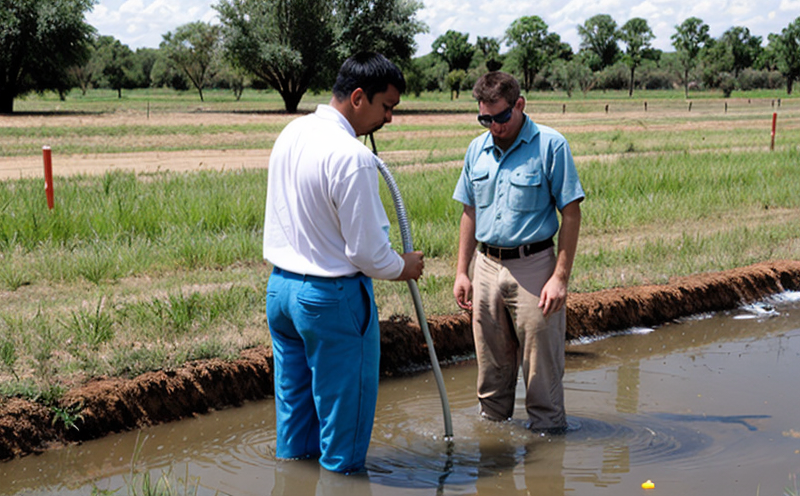APHA 5220C Chemical Oxygen Demand COD Test in Groundwater
The APHA 5220C method for the determination of chemical oxygen demand (COD) is a widely recognized and standardized approach used to measure the amount of oxidizable organic material present in water samples. This test is particularly important when assessing groundwater quality, as it helps identify potential contamination sources such as industrial effluents, agricultural runoff, or accidental spills.
The COD measurement provides insight into the total oxygen-requiring substances within a body of water by simulating an oxidation process in which all organic and inorganic reducible compounds are oxidized. This makes the test essential for environmental monitoring to ensure compliance with regulatory standards aimed at protecting public health, aquatic ecosystems, and natural resources.
The APHA 5220C method involves several key steps: sampling, sample preparation, chemical titration, and calculation of results. Groundwater samples are collected from various depths and locations within aquifers to capture a representative snapshot of the water quality. Once collected, these samples undergo rigorous pre-treatment to remove suspended solids and other particulates that could interfere with the test.
The core of the APHA 5220C method involves titrating the sample with potassium dichromate in the presence of an acid medium under controlled conditions. The reaction consumes oxygen from the water, which is then measured against a blank solution to determine the total amount of oxidizable material present. This process yields a COD value expressed as milligrams per liter (mg/L), providing a quantitative measure of contamination levels.
The accuracy and reliability of this test are crucial for environmental monitoring programs. Compliance officers and quality managers rely on such data to ensure that water sources meet regulatory standards set by organizations like the EPA or international bodies like ISO. By regularly performing COD tests, laboratories can identify trends over time and pinpoint areas requiring intervention.
The APHA 5220C method is part of a broader suite of analytical techniques used in environmental testing. It complements other analyses such as nutrient levels (e.g., nitrogen or phosphorus), heavy metal concentrations, and microbial indicators. Together, these tests form the basis for comprehensive groundwater quality assessments.
Groundwater contamination can have severe consequences if left unchecked. Elevated COD levels suggest increased biological activity due to organic matter decomposition, which might indicate a compromised aquifer. Continuous monitoring ensures that any changes in water chemistry are detected early, allowing for timely corrective actions.
The APHA 5220C method is not only useful for detecting contamination but also serves as an indicator of overall water quality. By integrating this test into routine testing protocols, organizations can maintain a proactive approach to environmental stewardship, ensuring sustainable practices and compliance with legal requirements.
Why Choose This Test
The APHA 5220C COD test is preferred for its robustness and reliability in measuring the total organic load within groundwater samples. Its standardized approach ensures consistent results across different laboratories, making it an ideal choice for regulatory compliance.
- Comprehensive Analysis: The method provides a broad spectrum of information about the water sample, including both organic and inorganic components.
- Rigorous Validation: This test has been validated against numerous international standards, ensuring its accuracy and precision.
- Regulatory Compliance: It aligns with global regulations set by bodies such as the EPA and ISO, making it a trusted choice for compliance officers.
- Precision and Accuracy: The APHA 5220C method offers high levels of precision, allowing for accurate quantification of COD in groundwater samples.
The test's versatility makes it applicable across various industries, including agriculture, manufacturing, and public utilities. By choosing this method, laboratories can ensure that their data is reliable and meets the highest standards of environmental testing.
Environmental and Sustainability Contributions
Groundwater contamination poses significant threats to both human health and ecosystem stability. The APHA 5220C COD test plays a crucial role in mitigating these risks by providing critical data that helps in the early detection of pollution.
In terms of environmental protection, this method supports sustainable water resource management. By identifying sources of contamination, it enables targeted interventions to prevent further degradation of groundwater quality. This proactive approach contributes significantly to the preservation of natural resources and biodiversity.
The test also plays a vital role in public health by ensuring that drinking water meets safety standards. Elevated COD levels can indicate the presence of pathogenic microorganisms or harmful chemicals, both of which pose risks to human health if not addressed promptly.
From an economic perspective, maintaining clean groundwater resources is essential for industries reliant on this resource. By preventing contamination and supporting sustainable practices, the APHA 5220C method contributes to long-term cost savings through reduced remediation efforts and improved operational efficiency.
The use of standardized methods like APHA 5220C fosters trust among stakeholders by providing transparent and reliable data. This enhances collaboration between regulatory bodies, environmental agencies, and private organizations, ultimately leading to more effective environmental policies and practices.
Use Cases and Application Examples
- Agricultural Monitoring: In agricultural regions, the APHA 5220C COD test can be used to monitor irrigation water quality. Excessive COD levels may indicate overuse of fertilizers or pesticides.
- Industrial Compliance: Manufacturers and industrial facilities must regularly test their effluent discharge into groundwater. The COD test ensures compliance with stringent environmental regulations.
- Urban Water Systems: Municipal water departments use this method to monitor the quality of water pumped from deep aquifers, ensuring it meets drinking water standards.
- Hydropower Plants: For hydroelectric facilities, groundwater testing is crucial for assessing potential impacts on aquatic ecosystems and ensuring compliance with licensing agreements.
- Aquifer Recharge Projects: Groundwater recharge initiatives often require regular COD monitoring to track the quality of injected water and prevent contamination of existing aquifers.
In each of these applications, the APHA 5220C method provides essential data that informs decision-making processes. Its versatility makes it a valuable tool in various sectors, from agriculture and industry to urban planning and environmental conservation.





